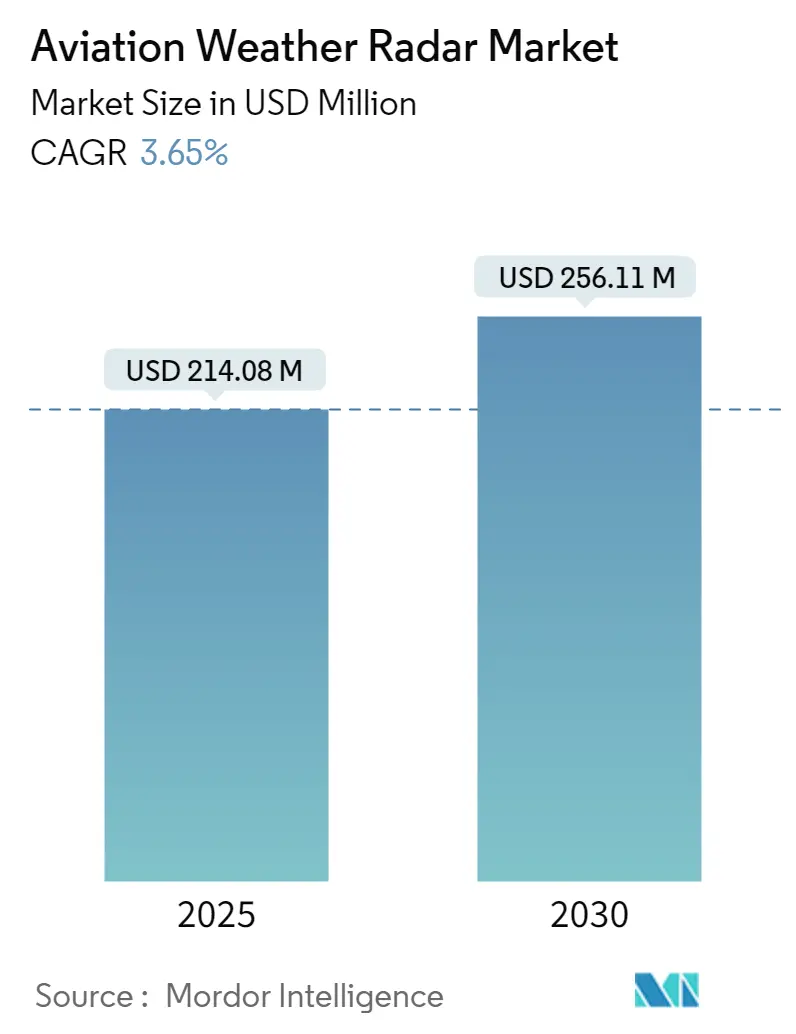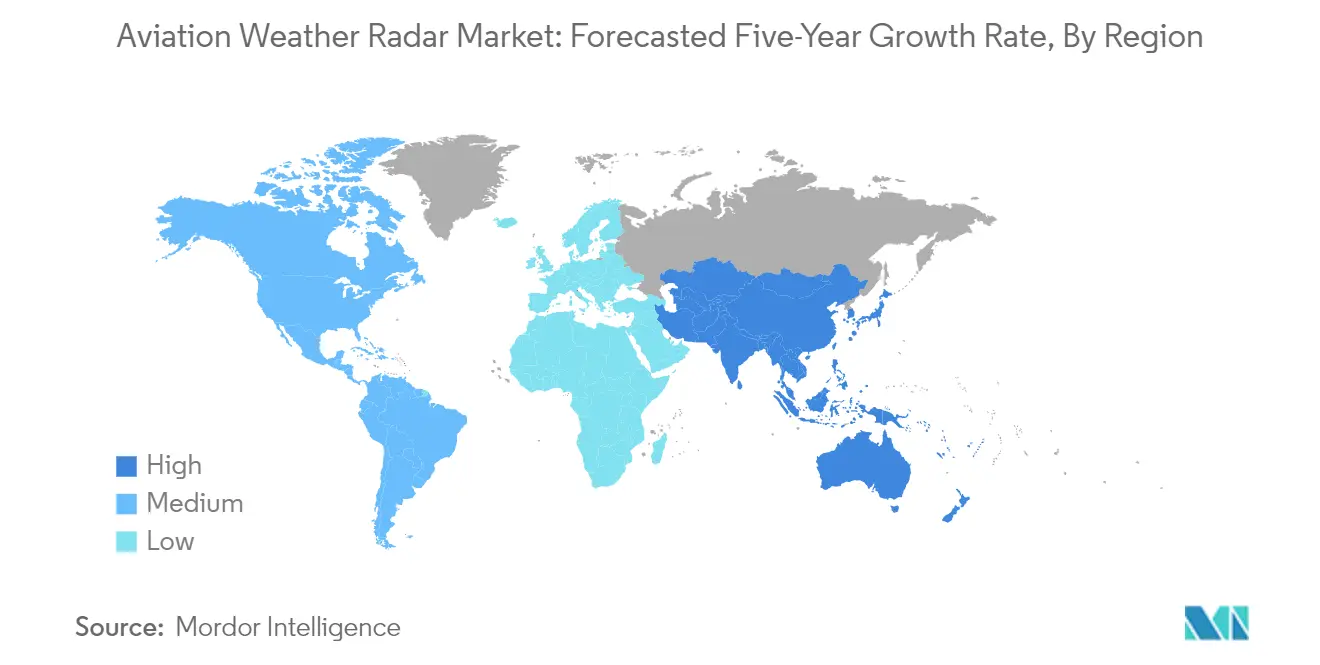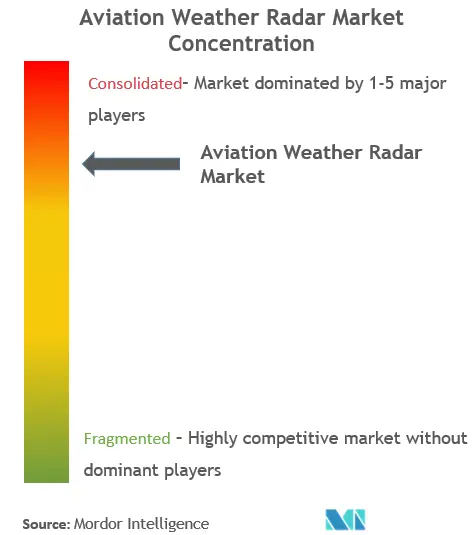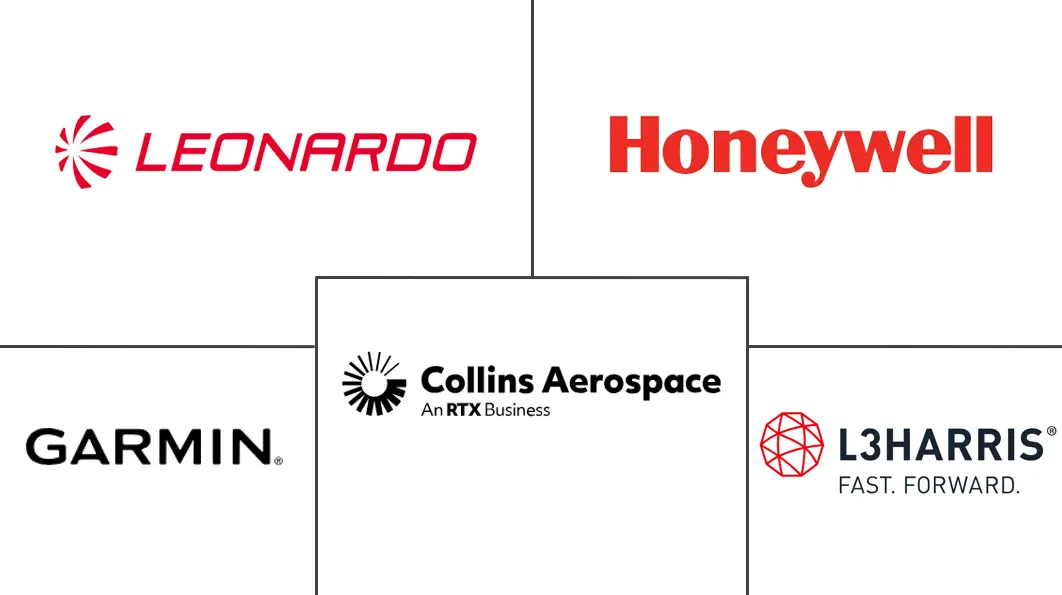Aviation Weather Radar Market Size and Share

Aviation Weather Radar Market Analysis by Mordor Intelligence
The Aviation Weather Radar Market size is estimated at USD 214.08 million in 2025, and is expected to reach USD 256.11 million by 2030, at a CAGR of 3.65% during the forecast period (2025-2030).
The aviation industry is experiencing a robust recovery and transformation, driven by increasing modernization initiatives and infrastructure developments across the globe. According to IATA projections, global air passenger traffic is expected to see significant growth, with forecasts indicating increases of 103% by 2024 and 111% by 2025 compared to pre-pandemic levels. This recovery is accompanied by substantial investments in airport infrastructure, with countries like Ethiopia constructing the USD 4 billion Addis Ababa International Airport, scheduled for completion in 2024 and designed to accommodate 120 million passengers. The industry's focus on modernization is evident in the increasing adoption of advanced navigation and safety systems across both commercial and military aviation sectors.
Military aviation continues to be a significant driver of technological advancement in the aviation radar sector, with several nations increasing their defense spending and modernization efforts. Notable developments include the UAE's procurement of 80 French-made Rafale fighter jets equipped with advanced Thales RBE2 passive electronically scanned multi-mode radar systems. The defense sector's emphasis on advanced radar capabilities has led to increased collaboration between military organizations and weather radar manufacturers, resulting in more sophisticated and reliable weather detection systems.
The industry is witnessing a significant shift toward more advanced radar technologies, particularly in the implementation of solid-state power amplifiers (SSPA) replacing traditional tube-based transmitters. This technological evolution enables the development of more compact, efficient radar systems that provide enhanced area coverage and improved accuracy while requiring less maintenance. In November 2022, Collins Aerospace achieved a milestone by receiving TSO certification for COMAC's C919 Weather Radar Flat Plate Antenna from the U.S. Federal Aviation Administration, demonstrating the industry's commitment to advancing radar technology.
Airport modernization initiatives are driving substantial investments in weather radar infrastructure worldwide. The trend toward upgrading existing facilities and constructing new airports has created increased demand for advanced aviation weather radar systems. For instance, Bahrain Meteorological Service has contracted MENA Aerospace Enterprises to upgrade the weather radar system at Bahrain International Airport, implementing advanced capabilities for forecasting adverse weather conditions. This modernization trend is particularly evident in emerging markets, where rapid aviation sector growth is necessitating sophisticated weather monitoring systems to ensure safe and efficient operations.
Global Aviation Weather Radar Market Trends and Insights
An Increase in Number of Air Travelers Boosts the Market Growth
The substantial rise in global air passenger traffic has created an increased demand for enhanced safety systems, particularly aviation weather radar technologies. According to International Air Transport Association (IATA) projections, passenger numbers are expected to reach 111% above pre-pandemic levels by 2025, necessitating significant investments in aviation safety infrastructure. This surge in air travel has prompted major airlines to expand their fleets with modern aircraft equipped with advanced aircraft weather radar capabilities. For instance, in June 2024, United Airlines placed a substantial order for a mix of 270 narrow-body aircraft, including 200 Boeing 737 MAX and 70 Airbus A321neo aircraft, worth more than USD 30 billion, all requiring state-of-the-art flight weather radar systems.
The growth in passenger traffic has also led to increased aircraft movements and airport operations, demanding more sophisticated weather monitoring capabilities. Airlines and airport operators are investing heavily in upgrading their existing aviation weather radar systems to handle the increased traffic safely and efficiently. This is evidenced by recent developments such as the deployment of advanced Terminal Doppler Weather Radar (TDWR) systems at major airports worldwide, which provide vital information and warnings about hazardous wind shear conditions, precipitation, gust fronts, and microbursts. These systems are crucial for managing the growing number of aircraft movements while maintaining the highest safety standards for the increasing passenger volumes.
Growing Adoption of Advanced Aviation Weather Radars to Enhance Passenger Safety
The aviation industry's commitment to passenger safety has driven significant technological advancements in airborne weather radar systems. Modern aviation weather radars have evolved to incorporate sophisticated features such as 3D volumetric scanning, predictive wind shear detection, and advanced ground clutter suppression. For example, Honeywell's latest RDR-7000 weather radar system, introduced for military applications, provides unparalleled weather insights and situational awareness, with the ability to automatically scan the sky from ground level to 60,000 feet and detect turbulence with greater accuracy at ranges of up to 320 nautical miles. These technological improvements directly contribute to enhanced passenger safety by providing pilots with more accurate and comprehensive aviation weather data.
The industry has also witnessed a significant shift towards solid-state power amplifiers (SSPA) from traditional tube-based transmitters, enabling more reliable and accurate weather detection capabilities. This advancement has resulted in improved assessment, prediction, and preparation for adverse weather conditions, particularly around airports. Recent implementations, such as Terma's SCANTER 5502 surface movement radars at major Indian airports in February 2024, demonstrate the industry's commitment to enhancing operational safety through advanced weather radar technology. Additionally, the integration of artificial intelligence and machine learning capabilities in newer weather radar systems has improved the accuracy of weather prediction and turbulence detection, further contributing to passenger safety by enabling pilots and air traffic controllers to make more informed decisions during adverse weather conditions.
Segment Analysis: By End User
Aircraft Segment in Aviation Weather Radar Market
The aircraft segment dominates the aviation weather radar market, commanding approximately 69% market share in 2024, driven by the increasing demand for advanced aircraft weather radar systems in commercial, military, and general aviation sectors. Modern aircraft manufacturers are integrating sophisticated weather radar for aircraft displays into navigation systems, with most aircraft featuring radar antennas in their nose (radome) that process and display real-time atmospheric data to pilots. The segment's growth is further propelled by the rising focus on passenger safety, with airlines investing in advanced radar systems that can detect various weather phenomena, including turbulence, wind shear, and precipitation patterns. Recent technological advancements include the development of Doppler radar systems that can detect both precipitation intensity and the motion of rain droplets, providing more comprehensive weather information to pilots. Companies like Vaisala, Collins Aerospace, and Honeywell International continue to innovate with new weather radar products that offer enhanced capabilities such as lightning detection, extended range coverage, and improved accuracy in harsh weather conditions.

Remaining Segments in Aviation Weather Radar Market by End User
The airport segment plays a crucial role in the aviation weather radar market, primarily through the implementation of Terminal Doppler Weather Radar (TDWR) systems that enhance the safety of National Airspace Systems. These systems are essential for air traffic controllers managing arrival and departure operations, providing vital information about hazardous weather conditions, wind shear, precipitation, and gust fronts near terminal approach and departure corridors. Airport weather radar systems are continuously being modernized with advanced capabilities, including improved detection ranges and sophisticated Doppler turbulence detection features. The integration of these systems helps airports maintain efficient operations while ensuring the safety of aircraft during critical phases of flight, particularly during adverse weather conditions.
Aviation Weather Radar Market Geography Segment Analysis
Aviation Weather Radar Market in North America
North America represents a dominant force in the aviation weather radar market, driven by its well-established aviation industry and extensive network of airports. The United States and Canada form the key markets in this region, with both countries maintaining sophisticated air traffic control systems and weather monitoring capabilities. The region's leadership position is supported by the presence of major aircraft manufacturers, advanced technological infrastructure, and stringent safety regulations that mandate the use of modern weather radar systems in both commercial and military aircraft.

Aviation Weather Radar Market in the United States
The United States stands as the largest market for aviation radar systems in North America, holding approximately 89% of the regional market share in 2024. The country's dominance is attributed to its extensive network of airports, large commercial aircraft fleet, and significant military aviation presence. The US Air Force's ongoing initiatives to improve fleet mission-capable rates and substantial defense budget allocations for air power have created a strong demand for advanced weather radar systems. The presence of major airlines with large aircraft orders and the continuous modernization of existing fleets further solidifies the United States' position as a key market for aviation weather radar systems.
Aviation Weather Radar Market Growth Dynamics in the United States
The United States is also experiencing the fastest growth in North America, with a projected CAGR of approximately 4% from 2024 to 2029. This growth is driven by increasing investments in advanced weather radar technologies and the modernization of existing systems. The country's focus on enhancing passenger safety through improved weather detection capabilities and the integration of sophisticated radar systems in new aircraft deliveries continues to fuel market expansion. The ongoing modernization of military aircraft fleets and the increasing adoption of advanced weather radar systems by commercial airlines contribute significantly to this growth trajectory.
Aviation Weather Radar Market in Europe
Europe represents a significant market for aviation weather radar systems, characterized by its strong aviation infrastructure and technological advancement. The region's market is shaped by key countries including Germany, the United Kingdom, France, and Italy, each contributing uniquely to the market dynamics. The presence of major aircraft manufacturers, robust research and development activities, and stringent safety regulations drive the adoption of advanced weather radar systems across both commercial and military aviation sectors.
Aviation Weather Radar Market in Germany
Germany emerges as the largest market for aviation weather radar systems in Europe, commanding approximately 29% of the regional market share in 2024. The country's leadership position is supported by its strong aerospace industry, significant military modernization programs, and robust commercial aviation sector. Germany's focus on upgrading its existing fleet with advanced weather radar systems and substantial investments in airport infrastructure development has established it as a key market for aviation weather radar technologies.
Aviation Weather Radar Market Growth Dynamics in the United Kingdom
The United Kingdom demonstrates the strongest growth potential in the European region, with a projected CAGR of approximately 5% from 2024 to 2029. The country's dynamic growth is driven by its continuous investment in advanced aviation technologies and modernization of both military and commercial aircraft fleets. The UK's commitment to enhancing air safety through improved weather detection capabilities and its strong focus on incorporating cutting-edge radar systems in new aircraft acquisitions positions it as a key growth market in the region.
Aviation Weather Radar Market in Asia-Pacific
The Asia-Pacific region represents a rapidly evolving market for aviation weather radar systems, characterized by significant investments in aviation infrastructure and growing air traffic. Key countries including China, India, Japan, and Australia are driving the market's expansion through their respective aviation development programs. The region's dynamic growth is supported by increasing air passenger traffic, expansion of airport infrastructure, and modernization of military aircraft fleets.
Aviation Weather Radar Market in China
China maintains its position as the largest market for aviation weather radar systems in the Asia-Pacific region. The country's dominance is attributed to its extensive aviation infrastructure development, large-scale airport construction projects, and significant investments in both commercial and military aviation sectors. China's commitment to enhancing its air transportation capabilities and modernizing its aircraft fleet continues to drive the demand for advanced weather radar systems.
Aviation Weather Radar Market Growth Dynamics in India
India emerges as the fastest-growing market in the Asia-Pacific region for aviation weather radar systems. The country's remarkable growth is driven by ambitious airport expansion plans, increasing domestic air travel, and significant investments in military aviation capabilities. India's focus on modernizing its aviation infrastructure and enhancing weather monitoring capabilities across its expanding network of airports positions it as a key growth market in the region.
Aviation Weather Radar Market in Latin America
Latin America represents an emerging market for aviation weather radar systems, with Brazil and Mexico serving as key growth drivers. The region's aviation sector is undergoing significant modernization, with increasing investments in airport infrastructure and aircraft fleet expansion. Brazil emerges as both the largest and fastest-growing market in the region, supported by its robust aerospace industry and significant military modernization programs. The region's focus on enhancing air safety through improved weather monitoring capabilities and the growing demand for advanced radar systems in both commercial and military aviation sectors continue to drive market growth.
Aviation Weather Radar Market in the Middle East & Africa
The Middle East & Africa region demonstrates strong potential in the aviation weather radar market, driven by significant investments in aviation infrastructure and military modernization programs. The United Arab Emirates and Saudi Arabia lead the market development through their ambitious aviation expansion plans and military modernization initiatives. The UAE emerges as the largest market in the region, while Saudi Arabia shows the fastest growth potential. The region's commitment to enhancing its aviation capabilities through advanced weather monitoring systems and the continuous expansion of airport infrastructure support the market's growth trajectory.
Competitive Landscape
Top Companies in Aviation Weather Radar Market
The aviation weather radar market is characterized by the strong presence of established aerospace and defense technology companies that are driving innovation through advanced radar systems and next-generation technologies. These weather radar manufacturers are focusing on developing sophisticated weather detection capabilities, enhanced display systems, and improved accuracy in turbulence prediction. Market leaders are emphasizing operational excellence through streamlined manufacturing processes, robust supply chain management, and strategic partnerships with aircraft manufacturers and airlines. Companies are also expanding their global footprint through regional service centers, authorized dealer networks, and collaboration with local maintenance providers. The competitive dynamics are shaped by continuous investment in research and development, particularly in areas like digital signal processing, automated weather analysis, and integration with other avionics systems.
Consolidated Market Led By Global Players
The aviation weather radar market exhibits a highly consolidated structure dominated by major aerospace conglomerates and specialized avionics manufacturers with an established global presence. These industry leaders, including Honeywell International, Garmin, Collins Aerospace, L3Harris Technologies, and Leonardo SpA, collectively command a significant portion of the radar market share through their comprehensive product portfolios and extensive service networks. The market's high entry barriers, stemming from substantial capital requirements, stringent regulatory compliance needs, and the necessity for advanced technological capabilities, have contributed to this concentrated competitive landscape.
The market demonstrates limited merger and acquisition activity, with companies instead focusing on organic growth through technological advancement and expansion of existing product lines. Major players typically enter into long-term contracts with aircraft manufacturers and operators, creating stable business relationships that further reinforce market positions. The competitive environment is characterized by companies leveraging their established brand reputation, technical expertise, and after-sales support capabilities to maintain their market standing, while regional players focus on specific market segments or geographical areas to maintain their competitive edge.
Innovation and Service Excellence Drive Success
Success in the aviation weather radar market increasingly depends on companies' ability to innovate while maintaining high reliability and safety standards. Market leaders are strengthening their positions through continuous investment in research and development, focusing on advanced technologies like automated weather detection systems, improved resolution capabilities, and integration with other aircraft systems. Companies are also expanding their service offerings, including comprehensive maintenance programs, training services, and technical support, to create additional value propositions for customers and enhance market retention.
For new entrants and smaller players, success lies in identifying and serving specific market niches or geographical regions where they can build specialized expertise. The market's high customer concentration, particularly among major airlines and aircraft manufacturers, necessitates building strong relationships and establishing credibility through proven performance and reliability. While the threat of substitution remains low due to the critical nature of weather radar systems in aviation safety, companies must stay ahead of evolving regulatory requirements and technological standards to maintain their competitive position. Future success will increasingly depend on the ability to offer integrated solutions that address the growing demands for improved weather detection accuracy, reduced maintenance requirements, and enhanced operational efficiency. The competitive radar environment requires aviation radar systems to be at the forefront of technological advancements, ensuring that weather radar manufacturers continue to meet the rigorous demands of the industry.
Aviation Weather Radar Industry Leaders
-
Honeywell International, Inc.
-
Garmin Ltd.
-
L3Harris Technologies, Inc.
-
Collins Aerospace (RTX Corporation)
-
Leonardo S.p.A
- *Disclaimer: Major Players sorted in no particular order

Recent Industry Developments
June 2024: OMNI Air Taxi (OMNI), South America's leading operator of Leonardo AW139 helicopters, awarded a significant contract to Honeywell International Inc. The agreement entails the upgradation of OMNI's 31 AW139s with Honeywell’s state-of-the-art IntuVue RDR-7000 Weather Radar System.
June 2023: Indonesia enhanced its airspace surveillance capabilities by procuring 13 long-range military radars from THALES. Opting for THALES' Ground Master 400 Alpha (GM400a), boasting a 515-kilometer range, Indonesia highlighted its appeal for integrating artificial intelligence, a feature streamlining data management.
Global Aviation Weather Radar Market Report Scope
An aviation weather radar, also known as a weather surveillance radar (WSR), is a crucial installation in both aircraft and airports. Its primary function is to detect and track various weather phenomena, such as precipitation, and to forecast weather patterns, including rain, snow, and hail. Modern aviation weather radars can even gauge the movement and intensity of raindrops.
The aviation weather radar market is segmented by end user and geography. By end user, the market is segmented into airports and aircraft. The aircraft segment is further segmented into commercial, general, and military aviation. The report also covers the market sizes and forecasts for the aviation weather radar market in major countries across different regions. For each segment, the market sizes and forecasts are provided in terms of value (USD).
| Airport | |
| Aircraft | Commercial Aviation |
| Military Aviation | |
| General Aviation |
| North America | United States |
| Canada | |
| Europe | United Kingdom |
| France | |
| Germany | |
| Russia | |
| Rest of Europe | |
| Asia-Pacific | China |
| India | |
| Japan | |
| South Korea | |
| Rest of Asia-Pacific | |
| Latin America | Brazil |
| Rest of Latin America | |
| Middle East and Africa | Saudi Arabia |
| United Arab Emirates | |
| Egypt | |
| Rest of Middle East and Africa |
| End User | Airport | |
| Aircraft | Commercial Aviation | |
| Military Aviation | ||
| General Aviation | ||
| Geography | North America | United States |
| Canada | ||
| Europe | United Kingdom | |
| France | ||
| Germany | ||
| Russia | ||
| Rest of Europe | ||
| Asia-Pacific | China | |
| India | ||
| Japan | ||
| South Korea | ||
| Rest of Asia-Pacific | ||
| Latin America | Brazil | |
| Rest of Latin America | ||
| Middle East and Africa | Saudi Arabia | |
| United Arab Emirates | ||
| Egypt | ||
| Rest of Middle East and Africa | ||
Key Questions Answered in the Report
How big is the Aviation Weather Radar Market?
The Aviation Weather Radar Market size is expected to reach USD 214.08 million in 2025 and grow at a CAGR of 3.65% to reach USD 256.11 million by 2030.
What is the current Aviation Weather Radar Market size?
In 2025, the Aviation Weather Radar Market size is expected to reach USD 214.08 million.
Who are the key players in Aviation Weather Radar Market?
Honeywell International, Inc., Garmin Ltd., L3Harris Technologies, Inc., Collins Aerospace (RTX Corporation) and Leonardo S.p.A are the major companies operating in the Aviation Weather Radar Market.
Which is the fastest growing region in Aviation Weather Radar Market?
Asia Pacific is estimated to grow at the highest CAGR over the forecast period (2025-2030).
Which region has the biggest share in Aviation Weather Radar Market?
In 2025, the Asia Pacific accounts for the largest market share in Aviation Weather Radar Market.
What years does this Aviation Weather Radar Market cover, and what was the market size in 2024?
In 2024, the Aviation Weather Radar Market size was estimated at USD 206.27 million. The report covers the Aviation Weather Radar Market historical market size for years: 2019, 2020, 2021, 2022, 2023 and 2024. The report also forecasts the Aviation Weather Radar Market size for years: 2025, 2026, 2027, 2028, 2029 and 2030.
Page last updated on:



